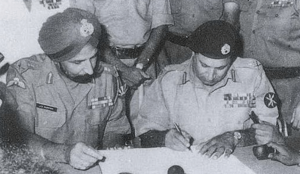Jagjit Singh Aurora facts for kids
Quick facts for kids
Lieutenant General
Jagjit Singh Aurora
PVSM
|
|
|---|---|

Aurora (left) taking Pakistani instrument of surrender in 1971
|
|
| Born | 13 February 1916 Kala Gujran, Jhelum District, Punjab, British India (now in Punjab, Pakistan) |
| Died | 3 May 2005 (aged 89) New Delhi, India |
| Allegiance | |
| Service/ |
|
| Years of service | 1939-1973 |
| Rank | |
| Service number | IC-214 |
| Unit | 2nd Punjab Regiment (until 1947) Punjab Regiment (after 1947) |
| Commands held | |
| Battles/wars | Burma Campaign, World War II Indo-Pakistani War of 1947 Sino-Indian War Indo-Pakistani War of 1965 Nathu La and Cho La clashes Indo-Pakistani War of 1971 |
| Awards | Param Vishisht Seva Medal Padma Bhushan Bir Protik |
Lieutenant General Jagjit Singh Aurora was a brave and respected Indian Army officer. He is best known for leading the Indian forces during the Indo-Pakistani War of 1971. This war led to the creation of Bangladesh, a new country.
General Aurora was in charge of the Eastern Command of the Indian Army. He played a key role in the victory that helped East Pakistan become independent. He accepted the surrender of the Pakistani forces in 1971, which was a huge moment in history.
After leaving the army, he became a politician. He served as a Member of Parliament in the Rajya Sabha, which is like one of the houses of the Indian Parliament.
Contents
Early Life and Military Beginnings
Jagjit Singh Aurora was born on February 13, 1916, in a place called Kala Gujran in British India. His family was Sikh, and his father was an engineer.
He joined the army after graduating from the Indian Military Academy in 1939. His first assignment was with the 2nd Punjab Regiment.
Serving in World War II
Aurora fought in World War II as part of the Burma Campaign. This was a series of battles in Southeast Asia.
After India's Independence
When India gained independence in 1947, Aurora chose to join the new Indian Army. He continued to serve in the Punjab Regiment. He also fought in the Indo-Pakistani War of 1947.
Over the years, he rose through the ranks. He became a Brigadier in 1957, leading an infantry brigade. In 1961, he even led a military mission to Bhutan.
Key Roles in Other Conflicts
General Aurora also took part in the Sino-Indian War in 1962. Later, he became a Major General and then the Director of Military Training. He also fought in the Indo-Pakistani War of 1965.
By 1966, he was promoted to Lieutenant General. In 1969, he became the General Officer Commanding-in-Chief (GOC-in-C) of the Eastern Command. This was a very important leadership role.
Leading the Way to Bangladesh
In March 1971, a major conflict began in East Pakistan. The Pakistan Army launched a harsh operation against the people of East Pakistan. This led to the Bangladesh Liberation War. Many people were killed, and millions fled to India as refugees.
A group of Bengali fighters called the Mukti Bahini formed to resist. They fought alongside Bengali soldiers who left the Pakistan Army.
Preparing for War
As tensions grew between India and Pakistan, General Aurora prepared his forces. For nine months, he worked to improve roads, communication, and bridges. He also moved huge amounts of supplies close to the border.
The 1971 War and Victory
When the Indo-Pakistani War of 1971 officially began on December 3, 1971, General Aurora led the Indian ground forces into East Pakistan. His plan was very clever. His troops formed small teams and attacked from four different directions. They focused on defeating Pakistani forces in key areas, while going around others.
In less than two weeks, his forces reached Dhaka, the capital of East Pakistan.
The Pakistani commander, Lieutenant General Amir Abdullah Khan Niazi, had no choice but to surrender. He signed an unconditional Pakistani Instrument of Surrender. This moment, with Niazi signing and Aurora standing beside him, became a famous image of the war. About 90,000 Pakistani soldiers surrendered to General Aurora. This was the largest surrender of soldiers since World War II. East Pakistan became the new country of Bangladesh.
Life After the Army
For his incredible leadership in the war, General Aurora received several high honors. These included the Param Vishisht Seva Medal, the Padma Bhushan, and the Bir Protik. He retired from the Indian Army in 1973.
Political Career and Activism
In 1984, General Aurora spoke out against the government's actions during Operation Blue Star. This was an operation where the army entered the Golden Temple in Amritsar, a very holy place for Sikhs.
He then became a member of the Rajya Sabha, which is the upper house of India's Parliament. He represented the Akali Dal political party. He also helped Sikh victims of the 1984 anti-Sikh riots by providing free legal help through the Citizen's Justice Committee.
His Legacy
Jagjit Singh Aurora passed away on May 3, 2005, at the age of 89, in New Delhi. He left behind a son and a daughter.
Bangladesh remembered his important role in their freedom. The Bangladeshi Foreign Minister, Morshed Khan, sent a message saying that Aurora would always be remembered for his help during their liberation war.
The place where the surrender was signed in 1971 is now a national monument called Swadhinata Stambha. It has a glass tower, an eternal flame, and murals that honor the martyrs.
See also
- Sam Manekshaw
- Bangladesh Liberation War


